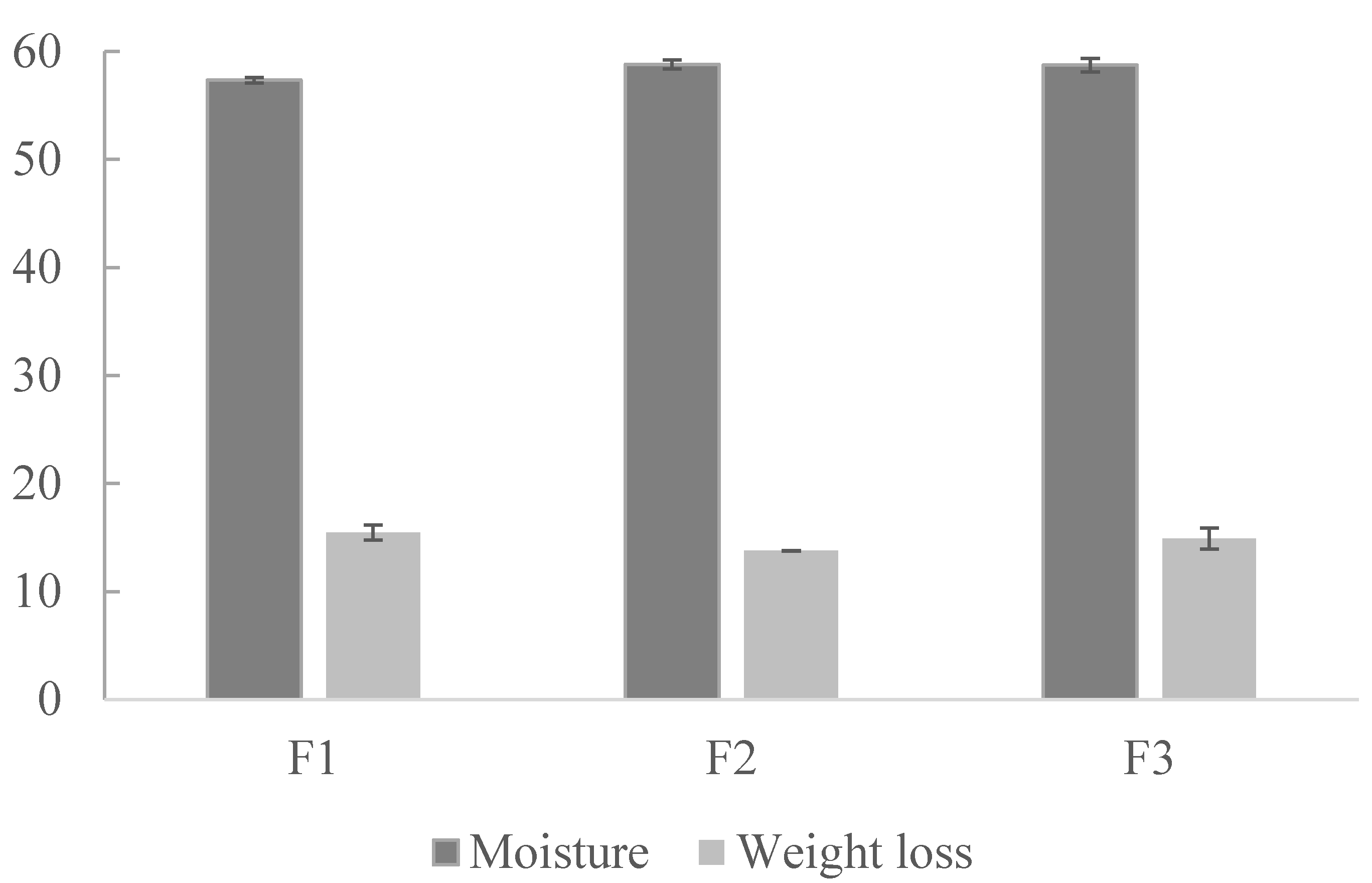Influence of the Use of Hydrocolloids in the Development of Gluten-Free Breads from Colocasia esculenta Flour †
Abstract
:1. Introduction
2. Materials and Methods
2.1. Materials
2.2. Flour Characteristics and Baking Process
2.3. Quality Assessment of the GF Breads
2.4. Statistical Analysis
3. Results
3.1. Proximate Composition of Raw Flour
3.2. Effect of Additives in Colocasia spp. Cormel Flour-Based Breads
4. Conclusions
Funding
Acknowledgments
References
- Capriles, V.D.; Arêas, J.A.G. Novel approaches in gluten-free breadmaking: Interface between food science, nutrition, and health. Compr. Rev. Food Sci. Food Saf. 2014, 13, 871–890. [Google Scholar] [CrossRef]
- Cornejo, F.; Rosell, C.M. Influence of germination time of brown rice in relation to flour and gluten free bread quality. J. Food Sci. Technol. 2015, 52, 6591–6598. [Google Scholar] [CrossRef] [PubMed]
- Calle, J.; Benavent-Gil, Y.; Rosell, C.M. Development of gluten free breads from Colocasia esculenta flour blended with hydrocolloids and enzymes. Food Hydrocol. 2020, 98, 105243. [Google Scholar] [CrossRef]
- Masure, H.G.; Fierens, E.; Delcour, J.A. Current and forward looking experimental approaches in gluten-free bread making research. J. Cereal Sci. 2016, 67, 92–111. [Google Scholar] [CrossRef]
- Calle, J.; Benavent-Gil, Y.; Garzón, R.; Rosell, C.M. Exploring the functionality of starches from corms and cormels of Xanthosoma sagittifolium. Int. J. Food Sci. Technol. 2019, 54, 2494–2501. [Google Scholar] [CrossRef]
- AACC. Method 56-30.01 Water Hydration Capacity of Protein Materials, 11th ed.; Method 44-15.02 Moisture—Air-Oven Methods, Approved Methods of Analysis; AACC International: St. Paul, MN, USA, 1999. [Google Scholar]
- Calle, J.; Villavicencio MNd Rosell, C.M.; Bernabé-Marques, C.J. Influencia de mezclas de hidrocoloides en la reología de la masa del pan libre de gluten. Cienc. Tecnol. Aliment. 2014, 2, 37–42. [Google Scholar]
- Marco, C.; Rosell, C.M. Breadmaking performance of protein enriched, gluten-free breads. Eur. Food Res. Technol. 2008, 227, 1205–1213. [Google Scholar] [CrossRef]
- Matos, M.E.; Rosell, C.M. Quality Indicators of Rice-Based Gluten-Free Bread-Like Products: Relationships Between Dough Rheology and Quality Characteristics. Food Bioprocess Technol. 2013, 6, 2331–2341. [Google Scholar] [CrossRef]
- Hager, A.-S.; Arendt, E.K. Influence of hydroxypropylmethylcellulose (HPMC), xanthan gum and their combination on loaf specific volume, crumb hardness and crumb grain characteristics of gluten-free breads based on rice, maize, teff and buckwheat. Food Hydrocol. 2013, 32, 195–203. [Google Scholar] [CrossRef]
- Pasqualone, A.; Caponio, F.; Summo, C.; Paradiso, V.M.; Bottega, G.; Pagani, M.A. Gluten-free bread making trials from cassava (manihot Esculenta Crantz) flour and sensory evaluation of the final product. Int. J. Food Prop. 2010, 13, 562–573. [Google Scholar] [CrossRef]
- Yadav, A.R.; Guha, M.; Tharanathan, R.; Ramteke, R. Changes in characteristics of sweet potato flour prepared by different drying techniques. LWT Food Sci. Technol. 2006, 39, 20–26. [Google Scholar] [CrossRef]
- Liu, X.; Mu, T.; Sun, H.; Zhang, M.; Chen, J.; Fauconnier, M.L. Influence of different hydrocolloids on dough thermo-mechanical properties and in vitro starch digestibility of gluten-free steamed bread based on potato flour. Food Chem. 2018, 239, 1064–1074. [Google Scholar] [CrossRef] [PubMed]
- Sasaki, T. Effects of xanthan and guar gums on starch digestibility and texture of rice flour blend bread. Cereal Chem. 2018, 95, 177–184. [Google Scholar] [CrossRef]

| Ingredients | F1 | F2 | F3 |
|---|---|---|---|
| Flour (g) | 100 | 100 | 100 |
| Water (g) | 227 | 227 | 227 |
| Salt (g) | 1.5 | 1.5 | 1.5 |
| Compressed Yeast (g) | 3 | 3 | 3 |
| Sugar (g) | 2 | 2 | 2 |
| Oil (g) | 2 | 2 | 2 |
| HPMC (g) | - | 2 | 0.29 |
| Xanthan gum (g) | - | - | 0.21 |
| Guar gum (g) | - | - | 0.50 |
Publisher’s Note: MDPI stays neutral with regard to jurisdictional claims in published maps and institutional affiliations. |
© 2020 by the authors. Licensee MDPI, Basel, Switzerland. This article is an open access article distributed under the terms and conditions of the Creative Commons Attribution (CC BY) license (https://creativecommons.org/licenses/by/4.0/).
Share and Cite
Calle, J.; Benavent-Gil, Y.; Rosell, C.M. Influence of the Use of Hydrocolloids in the Development of Gluten-Free Breads from Colocasia esculenta Flour. Proceedings 2020, 53, 6. https://doi.org/10.3390/proceedings2020053006
Calle J, Benavent-Gil Y, Rosell CM. Influence of the Use of Hydrocolloids in the Development of Gluten-Free Breads from Colocasia esculenta Flour. Proceedings. 2020; 53(1):6. https://doi.org/10.3390/proceedings2020053006
Chicago/Turabian StyleCalle, Jehannara, Yaiza Benavent-Gil, and Cristina M. Rosell. 2020. "Influence of the Use of Hydrocolloids in the Development of Gluten-Free Breads from Colocasia esculenta Flour" Proceedings 53, no. 1: 6. https://doi.org/10.3390/proceedings2020053006
APA StyleCalle, J., Benavent-Gil, Y., & Rosell, C. M. (2020). Influence of the Use of Hydrocolloids in the Development of Gluten-Free Breads from Colocasia esculenta Flour. Proceedings, 53(1), 6. https://doi.org/10.3390/proceedings2020053006





